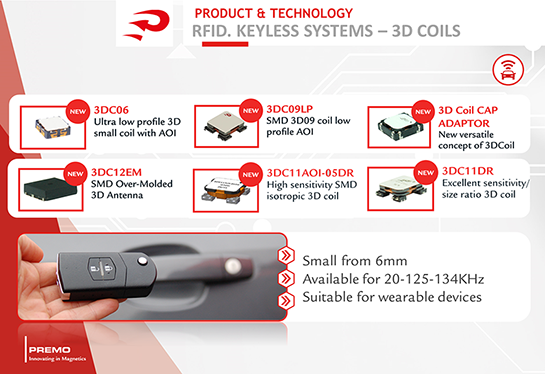3DCoils 3-Axes RFID Transponders











| Freq. (kHz) | Lx (mH) | Ly (mH) | Lz (mH) | Qx Min | Qy Min | Qz Min | Height (mm) | Length (mm) | Width (mm) |
|---|---|---|---|---|---|---|---|---|---|
| 125 | 3.45 | 3.45 | 10.5 | 17 | 15 | 24 | 2.3 | 7 | 7 |
| 125 | 3.45 | 3.45 | 10.5 | 12 | 12 | 20 | 2.45 | 7,9 | 7.9 |
| 125 | 7.2 | 7.2 | 7.2 | 19 | 19 | 21 | 3.1 | 11.0 | 9.5 |
| 125 | 2.38 | 2.38 | 2.38 | 18 | 18 | 18 | 3.15 | 13.0 | 11.6 |
| 125 | 2.47 | 2.47 | 2.47 | 17 | 17 | 17 | 3.15 | 13.0 | 11.6 |
| 125 | 3.45 | 3.45 | 3.45 | 15 | 15 | 15 | 3.15 | 13.0 | 11.6 |
| 125 | 4.05 | 4.05 | 4.05 | 15 | 15 | 15 | 3.15 | 13.0 | 11.6 |
| 125 | 4.91 | 4.91 | 4.91 | 18 | 18 | 18 | 3.15 | 13.0 | 11.6 |
| 125 | 7.2 | 7.2 | 7.2 | 15 | 15 | 15 | 3.15 | 13.0 | 11.6 |
| 20 | 20 | 20 | 20 | 5 | 5 | 5 | 3.15 | 13.0 | 11.6 |
| 125 | 2.38 | 2.38 | 2.38 | 17 | 17 | 17 | 3.7 | 13.0 | 12.8 |
| 125 | 4.91 | 4.91 | 4.91 | 15 | 15 | 15 | 3.7 | 13.0 | 12.8 |
RFID Transponder.
RFID Transponder Definition.
The Radio-Frequency Identification (RFID) system contains two basic parts; the RFID transmitter/reader which transmits energy, and an RFID tag/transponder located on the object.
The RFID transponder is commonly used in a wide variety of applications such as Automotive Passive Keyless Entry (PKE) systems, Tire Pressure Monitoring System (TPMS), animal identification, etc.
Types of RFID transponders:
- Single Axis Transponder: send information in one direction. Perfect for TPMS Systems.
- Three-Axis Transponder: is a combination of three single axis devices that allow the system to work regardless of the orientation of the key. A perfect solution for PKE/KES
Electrical and mechanical requirements to select the right RFID Transformers.
To select the proper RFID transponder coil it is important to keep in mind some electrical and mechanical parameters. We review the necessary parameters here:
Inductance:
This is the main parameter of the RFID transponder. A higher inductance, equates to better performance inside the magnetic field.
The inductance needed on an RFID transponder should works with a capacitor as LC tank, so inductance should be matched with the capacitor
Q factor:
The Quality factor identifies the relationship between Inductance and Resistance. An RFID transponder with high Q factor has a resonance with more amplitude but has lower bandwidth. This means you get a greater “Reading” distance but may be more affected by deviations in the tuning of the transponder during the manufacturing process.
Some IC chips may need a minimum Q factor for proper operation.
DC Resistance:
This parameter is strongly linked with the Q factor parameter and can be reduced using larger wire diameter. Careful consideration should be given to the maximum resistance specified for the IC..
The RFID Chips have an impedance limit, so there is always a DCR max limit on the winding.
SRF:
The Self-Resonance Frequency (SRF) of the RFID transponder is the frequency at which inductive and capacitive components of the transponder impedance are equal.
At that frequency, the RFID transponder stops working as an inductor and starts working as capacitor. The practical rule is that SRF should be almost twice that of the working frequency of the RFID transponder.
Sensitivity:
Sensitivity refers to the level of induced voltage in the RFID transponder coil at a certain level of field power. Its unit is typically represented as mV/A/m or mV/uT.
Higher sensitivity means that the coil/transponder catches more power from magnetic field (allowing proper operation of the IC chip). Usually, the chip needs some minimal of sensitivity value.
Capacitive and inductive coupling (parasitic):
Capacitive and inductive coupling limit SRF of the RFID transponder and the working frequency.
In order to minimize this coupling: increase the winding pitch, using larger diameter wire, or using several sections of windings instead one section (this is related to the non-orthogonality of the three-axis of the 3D coil.)
Buy online RFID Transponders Online.
PREMO is the leading manufacturer in RFID transponder designs for SMD assembly processes focused mainly on automotive, Internet of Things (IOT), animal identification and industrial logistics applications.
Most of the standard coils produced by PREMO are specifically developed for automotive applications with recommended frequency of 125KHz. Other common application is animal ID application which requires 134KHz RFID transponders.
Main advantages of PREMO transponders:
- - A broad variety of standard products at competitive prices.
- - Highest sensitivity in the market with the lowest profile.
- - Stable performance across full operating temperature range -40ºC ~ +125ºC.
- - High Q factor and low Rdc (allows for higher current capacity.)
- - Different mechanical options for different mounting requirements.
- - Highest raw material quality and performance.
- - High-quality standards ISO & TS. (should TS be replaced with IATF)
- - Full customization upon request.

You can review technical specifications and buy all Premo 3-axis RFID Transponders online by clicking on each part on their webpage.
Also, if you need technical help to select the right transponder for your application, you can contact one of our engineer experts via our Contact FormContact Form or via our live chat from any of our web pages.





















